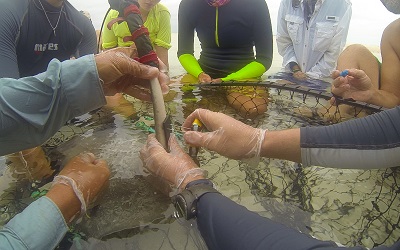 In the past week, members of the Stingray Research Team from the Shark Research and Conservation Program (SRCP) have begun work on a new project investigating the thermal ecology of southern stingrays (Dasyatis americana). As part of the research for this new study, the stingray team, assisted by gap year students and interns, fitted southern stingrays with temperature recorders. These recorders monitor seawater temperatures experienced by stingrays every 15 minutes for 3 weeks.
In the past week, members of the Stingray Research Team from the Shark Research and Conservation Program (SRCP) have begun work on a new project investigating the thermal ecology of southern stingrays (Dasyatis americana). As part of the research for this new study, the stingray team, assisted by gap year students and interns, fitted southern stingrays with temperature recorders. These recorders monitor seawater temperatures experienced by stingrays every 15 minutes for 3 weeks.
All sharks and rays are ectotherms, meaning their internal body temperature is controlled by the temperature of the environment around them. As such, changes in seawater temperature can impact the physiological processes of the animals, which may mean that temperature differences among the coastal waters of Eleuthera influence the areas which rays use.
Over the next 4 months, the study aims to tag 50 rays at both Marker Bar and the Schooner Cays, as well as conduct laboratory experiments with rays to identify thermal preferences. Also, temperature tags fitted to wild individuals will aid in understanding whether temperature is a driver of habitat selection in this ray species. Quantifying the drivers for habitat use of these ecologically important species is vital to effectively manage coastal marine habitats. The research is led by Daniel Montgomery, a postgraduate research student at Newcastle University, who is working in collaboration with Dr. Owen O’Shea and CEI.

